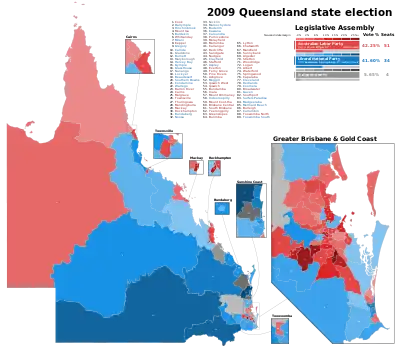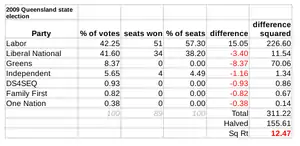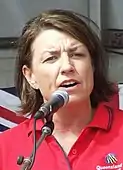| |||||||||||||||||||||||||||||||||||||||||||||||||||||
All 89 seats in the Legislative Assembly of Queensland 45 Assembly seats were needed for a majority | |||||||||||||||||||||||||||||||||||||||||||||||||||||
|---|---|---|---|---|---|---|---|---|---|---|---|---|---|---|---|---|---|---|---|---|---|---|---|---|---|---|---|---|---|---|---|---|---|---|---|---|---|---|---|---|---|---|---|---|---|---|---|---|---|---|---|---|---|
| Turnout | 90.93 ( | ||||||||||||||||||||||||||||||||||||||||||||||||||||
| |||||||||||||||||||||||||||||||||||||||||||||||||||||
 Winning margin by electorate. | |||||||||||||||||||||||||||||||||||||||||||||||||||||
| |||||||||||||||||||||||||||||||||||||||||||||||||||||
The 2009 Queensland state election was held on 21 March 2009 to elect all 89 members of the Legislative Assembly, a unicameral parliament.
The election saw the incumbent Labor government led by Premier Anna Bligh defeat the Liberal National Party of Queensland led by Opposition Leader Lawrence Springborg, and gain a fifth consecutive term in office for her party. Bligh thus became the first female Premier of any Australian State elected in her own right.[1]
The 2009 election marked the eighth consecutive victory of Labor in a general election since 1989, although it was out of office between 1996 and 1998 as a direct result of the 1996 Mundingburra by-election.
Key dates
| Date | Event |
|---|---|
| 23 February 2009 | Writs were issued by the Governor to proceed with an election.[2] |
| 28 February 2009 | Close of electoral rolls |
| 3 March 2009 | Close of nominations |
| 21 March 2009 | Polling day, between the hours of 8am and 6pm |
| 26 March 2009 | The Bligh Ministry was reconstituted[3] |
| 7 April 2009 | The writ was returned and the results formally declared |
| 12 April 2009 | 53rd Parliament convened |
Results


|
Queensland state election, 21 March 2009[4] | ||||||
|---|---|---|---|---|---|---|
| Enrolled voters | 2,660,940 | |||||
| Votes cast | 2,419,559 | Turnout | 90.93 | +0.46 | ||
| Informal votes | 46,908 | Informal | 1.94 | –0.14 | ||
| Summary of votes by party | ||||||
| Party | Primary votes | % | Swing | Seats | Change | |
| Labor | 1,002,415 | 42.25 | –4.67 | 51 | –8 | |
| Liberal National | 987,018 | 41.60 | +3.68 | 34 | +9 | |
| Greens | 198,475 | 8.37 | +0.38 | 0 | ±0 | |
| DS4SEQ | 22,170 | 0.93 | +0.93 | 0 | ±0 | |
| Family First | 19,379 | 0.82 | –1.07 | 0 | ±0 | |
| One Nation | 9,038 | 0.38 | –0.22 | 0 | –1 | |
| Independent | 134,156 | 5.65 | +0.97 | 4 | ±0 | |
| Total | 2,372,651 | 89 | ||||
| Two-party-preferred | ||||||
| Labor | 50.9 | −4.1 | ||||
| Liberal National | 49.1 | +4.1 | ||||
| * The two-party preferred summary is an estimate by Antony Green using a methodology by Malcolm Mackerras. | ||||||
Seats changing hands
| Seat | Pre-2009 | Swing | Post-2009 | ||||||
| Party | Member | Margin | Margin | Member | Party | ||||
| Aspley | Labor | Bonny Barry | 3.0 | -7.5 | 4.5 | Tracy Davis | Liberal National | ||
| Burdekin | Labor | notional | 0.9 | -4.0 | 3.1 | Rosemary Menkens | Liberal National | ||
| Clayfield | Labor | notional | 0.2 | -6.1 | 5.8 | Tim Nicholls | Liberal National | ||
| Cleveland | Labor | Phil Weightman | 0.5 | -1.5 | 0.3 | Mark Robinson | Liberal National | ||
| Coomera | Labor | notional | 8.3 | -10.2 | 1.9 | Michael Crandon | Liberal National | ||
| Gaven | Labor | Phil Gray | 3.1 | -3.9 | 0.7 | Alex Douglas | Liberal National | ||
| Hervey Bay | Labor | Andrew McNamara | 2.1 | -8.6 | 6.5 | Ted Sorensen | Liberal National | ||
| Indooroopilly | Greens | Ronan Lee | N/A ¶ | -8.6 | 5.9 | Scott Emerson | Liberal National | ||
| Mirani | Labor | notional | 1.2 | -1.8 | 0.6 | Ted Malone | Liberal National | ||
| Mudgeeraba | Labor | Dianne Reilly | 2.9 | -6.6 | 3.9 | Ros Bates | Liberal National | ||
| Redlands | Labor | John English | 6.8 | -6.9 | 0.1 | Peter Dowling | Liberal National | ||
¶ Ronan Lee was elected as a member of the Labor Party in 2006, but he defected to the Greens in 2008.
One of the gains by the Liberal Nationals was the defeat of the Minister for Sustainability, Climate Change and Innovation Andrew McNamara (Hervey Bay). The Parliamentary Secretary to the Minister for Education, Training and the Arts, Bonny Barry (Aspley), was also defeated.
Date
The previous state election was held on 9 September 2006 to elect the 89 members of the Legislative Assembly. In Queensland, for the government to serve a full-term, an election will be held approximately three years following the previous election. In Queensland, Section 80 of the Electoral Act 1992 states that an election must be held on a Saturday; and that the election campaign must run for a minimum of 26 or a maximum of 56 days following the issue of the writs. Five to seven days following the issue of the writs, the electoral roll is closed, which gives voters a final opportunity to enrol or to notify the Electoral Commission of Queensland of any changes in their place of residence.[5]
Legislative Assembly
The Labor Party, led by Premier Anna Bligh, and the LNP, led by Opposition Leader Lawrence Springborg, were the two main parties in Queensland at the election. It was the first election contested by the LNP following its creation with the merger of the National and Liberal parties. At the previous election, Labor won 59 seats, the Nationals won 17 seats, the Liberals won eight seats, One Nation won one seat, and independents won four seats. Former Labor MP Ronan Lee joined the Greens in 2008, thus becoming their parliamentary leader. Lee lost his seat at the election.[6]
A redistribution saw Labor notionally pick up three seats. Therefore, the LNP notionally needed to pick up 22 seats rather than 20 seats to form a majority government, which equated to an unchanged uniform 8.3 percent two party preferred swing.[7]
Former Premier Peter Beattie resigned in September 2007, which triggered the October 2007 Brisbane Central by-election.
Parties contesting the election
| Party | Seats Contested (2009) |
Seats Contested (2006) |
|---|---|---|
| Australian Labor Party | 89 | 89 |
| LNP | 88 | 89† |
| The Greens | 89 | 75 |
| DS4SEQ | 32 | N/A |
| Family First | 25 | 26 |
| One Nation | 2 | 4 |
| Independents & Others | 72 | 46 |
† Contested 2006 elections as Liberal Party (49 seats) and National Party (40) seats.
Both the Australian Labor Party and the Greens contested all 89 seats. This was the first Queensland state election in which the Greens contested every seat. The LNP contested every seat except Gladstone (held by an Independent), which they avoided for strategic reasons. A total of 397 candidates contested the election—the largest number of candidates to contest a Queensland election since 1998.
Post-election pendulum
Polling
Newspoll polling was conducted via random telephone number selection in city and country areas. Sampling sizes usually consist of around 1000 electors, with the declared margin of error at around ±3 percent.
| Date | Labor Bligh |
Coalition/LNP Springborg |
|---|---|---|
| 18 – 19 Mar 2009 | 53% | 33% |
| 27 Feb – 8 Mar 2009 | 48% | 34% |
| Jan – Feb 2009 | 48% | 31% |
| Oct – Dec 2008 | 49% | 30% |
| Jul – Sep 2008 | 53% | 27% |
| Apr – Jun 2008 | 60% | 24% |
| Jan – Mar 2008 | 64% | 18% |
| Oct – Dec 2007 | 66% | 11%2 |
| Jul – Sep 2007 | 54%1 | 25%2 |
| Apr – Jun 2007 | 54%1 | 19%2 |
| Pre 2006 election | 58%1 | 28% |
| Pre 2004 election | 62%1 | 22% |
| Polling conducted by Newspoll and published in The Australian. ^ Remainder were "uncommitted" to either leader. 1 Peter Beattie, 2 Jeff Seeney | ||
| Political parties | Two party preferred | |||||||||
|---|---|---|---|---|---|---|---|---|---|---|
| Dates | ALP | Lib | Nat | LNP | Grn | FFP | Oth | ALP | LNP | |
| 18 – 19 Mar 2009 | 42% | 42% | 7% | 0.5% | 8% | 49.9% | 50.1% | |||
| 27 Feb – 8 Mar 2009 | 41% | 43% | 8% | <0.5% | 8% | 49% | 51% | |||
| Jan – Feb 2009 | 42% | 41% | 7% | <0.5% | 10% | 53% | 47% | |||
| Oct – Dec 2008 | 45% | 37% | 8% | <0.5% | 10% | 57% | 43% | |||
| Jul – Sep 2008 | 38% | 41% | 9% | 1% | 11% | 51% | 49% | |||
| Apr – Jun 2008 | 43% | 26% | 12% | 38% | 10% | <0.5% | 9% | 55% | 45% | |
| Jan – Mar 2008 | 50% | 22% | 10% | 32% | 8% | <0.5% | 10% | 60% | 40% | |
| Oct – Dec 2007 | 50% | 26% | 9% | 35% | 6% | 1% | 8% | 59% | 41% | |
| Jul – Sep 2007 | 50% | 21% | 12% | 33% | 5% | 2% | 10% | 59% | 41% | |
| Apr – Jun 2007 | 51% | 20% | 11% | 31% | 6% | 1% | 11% | 61% | 39% | |
| 2006 election | 46.9% | 20.1% | 17.8% | 37.9% | 8.0% | 1.9% | 5.3% | 55.0% | 45.0% | |
| 6 – 7 Sep 2006 | 48% | 21% | 17% | 38% | 4% | 1% | 9% | 55% | 45% | |
| 2004 election | 47% | 18.5% | 17% | 35.5% | 6.7% | 4.9% | 5.9% | 55.5% | 44.5% | |
| Polling conducted by Newspoll and published in The Australian. | ||||||||||
See also
Notes
References
- ↑ "Queensland elects female premier". BBC News Online. 21 March 2009.
- ↑ "Election Timetable: 2009 State General Election". Electoral Commission of Queensland. Archived from the original on 17 March 2012.
- ↑ Queensland, Gazette: Extraordinary Archived March 17, 2012, at the Wayback Machine, No 71, 26 March 2009, 1307
- ↑ ECQ. "Parliament of Queensland, Assembly election, 21 March 2009". Archived from the original on 26 February 2011.
- ↑ Electoral Act 1992
- ↑ "Qld Labor MP jumps ship to Greens". ABC News. 5 October 2008. Retrieved 9 August 2018.
- ↑ "2008 QLD redistribution". ABC. 21 March 2009. Retrieved 25 January 2012.

